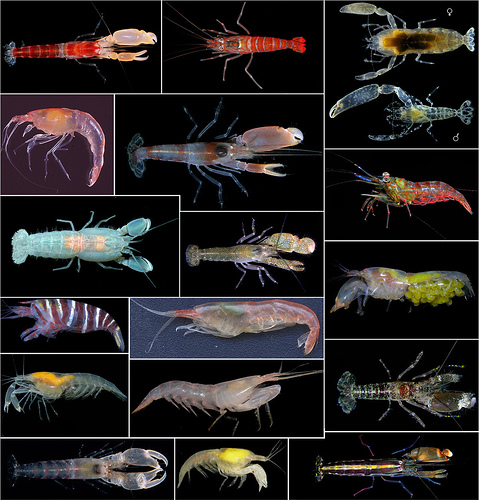LOBSTERS
There are two basic lobsters to be familiar with - the clawed lobster and the spiny lobster. Both are primarily scavengers. The clawed lobster has two different claws - a lighter faster shredder and a heavier more powerful crusher. The clawed lobster is more solitary because it is more aggressive. The spiny lobster does not have big claws, but can defend itself with its long whip like antennae. This lobster likes to congregate in groups and is not as aggressive. Both lobsters carry their eggs on the swimmerettes protecting them from potential predators.
 |
| Left: male ; Right: Female |
- Blue Crabs are found in the Chesapeake Bay. They are very agressive, like to pinch, but are good to eat. They have a pointy-ended shell and swim fins. (you can kind of see the swim fins on the last leg of the crabs on the right)
- Spider Crabs have a rounder body shape, often a bumpy shell that will grow algae for camouflage, and longer more spindly legs. Spider Crabs include snow crabs and king crabs like the ones seen on Deadliest Catch.
- Fiddler Crab males have one claw that is a lot bigger than the other. This is for impressing the ladies, and used to show dominance over other males.
- Hermit Crabs have a weak exoskeleton and thus protect it with a stolen mollusc shell. They have adapted to this lifestyle and have modified back legs that hook on the inside to hold the shell on and one claw that is slightly larger to use as an operculum.
SHRIMP - miniature lobsters... use their swimmerettes to keep themselves moving - most Americans have never seen one with its head and legs still attached!
- Gulf shrimp are the ones people most people are familiar with because these are the ones we eat!
- Shore shrimp live in sea grasses, are fairly small and clear, and are not commercially harvested because no one would make any money.
- Snapping shrimp have slightly larger claws and can use them to make sonic waves to stun their prey with sound.
- Mantis shrimp whack their prey with arms that can unfold and strike lightning quick.
- Cleaner shrimp make their living eating parasites off of fish and other sea creatures.
BARNACLES
If you look at a diagram, barnacles are like little shrimp glued on their backs with a white fence around them. They stick their feathery legs out to filter feed plankton. They are plankton for a while and once settled and glues onto a hard substrate never move again. This makes mating difficult, but the hermaphroditic barnacles have special talents. Gooseneck barnacles have a stalk that they attach to substrates with.






No comments:
Post a Comment